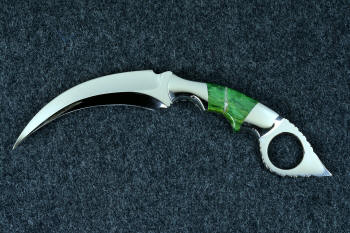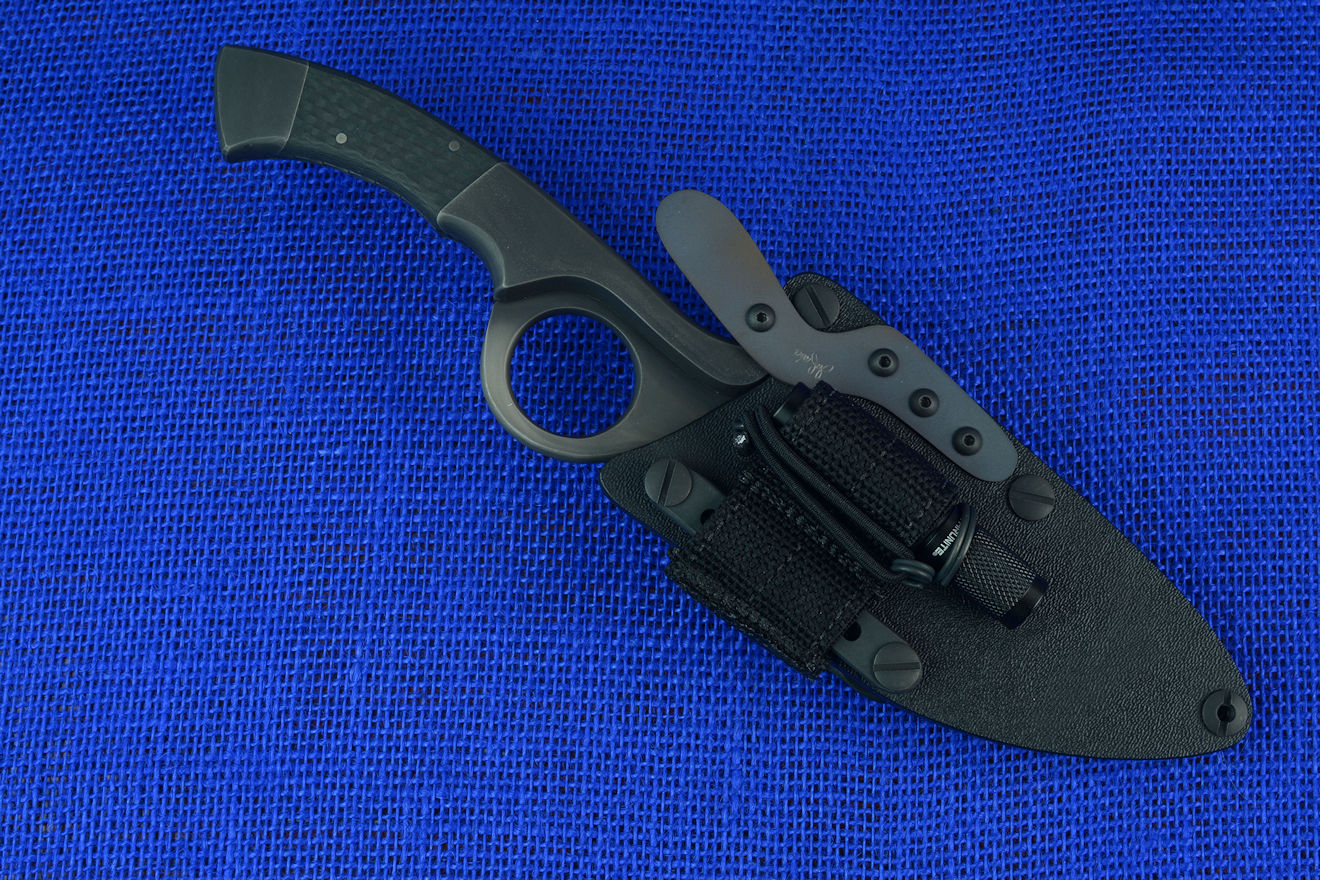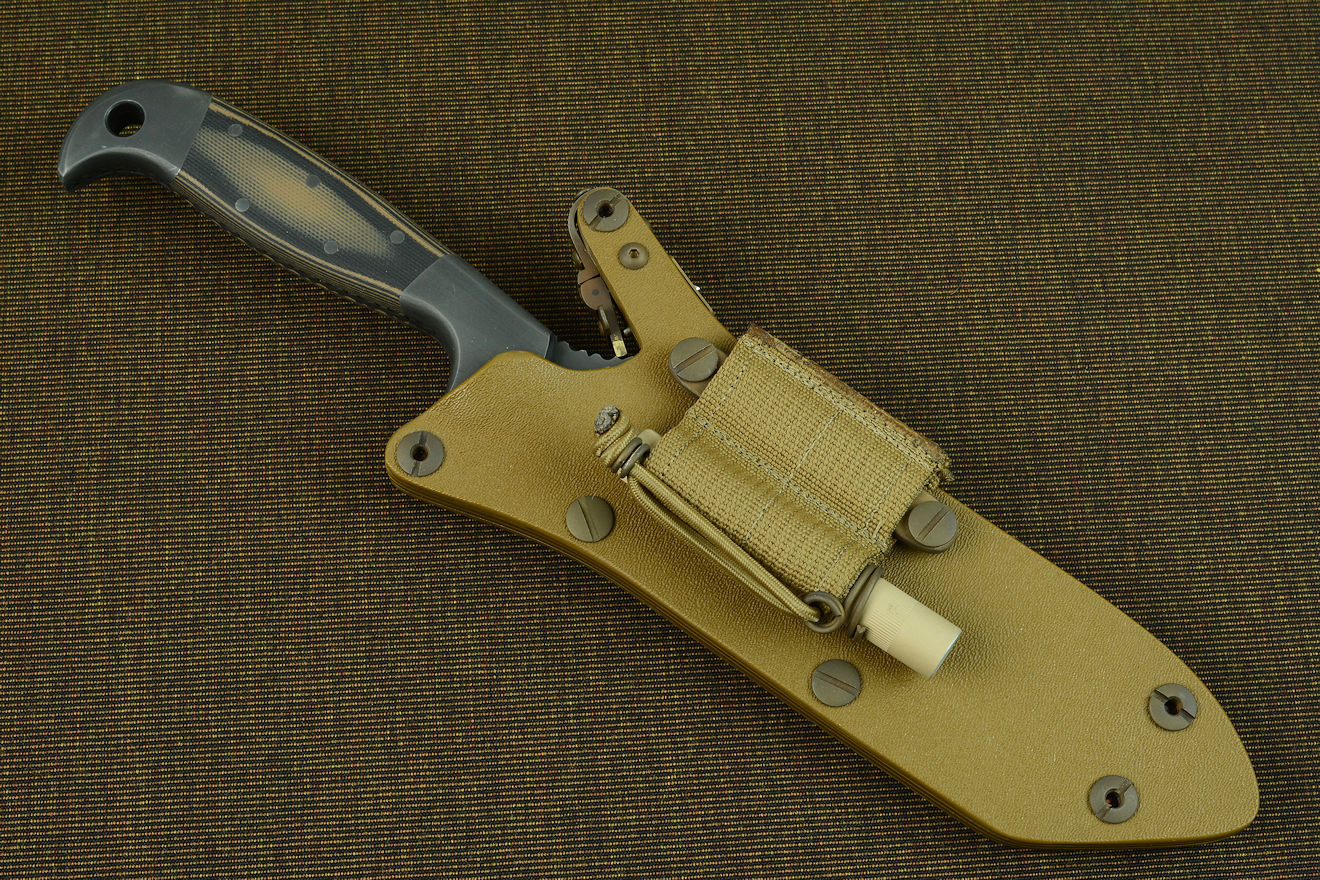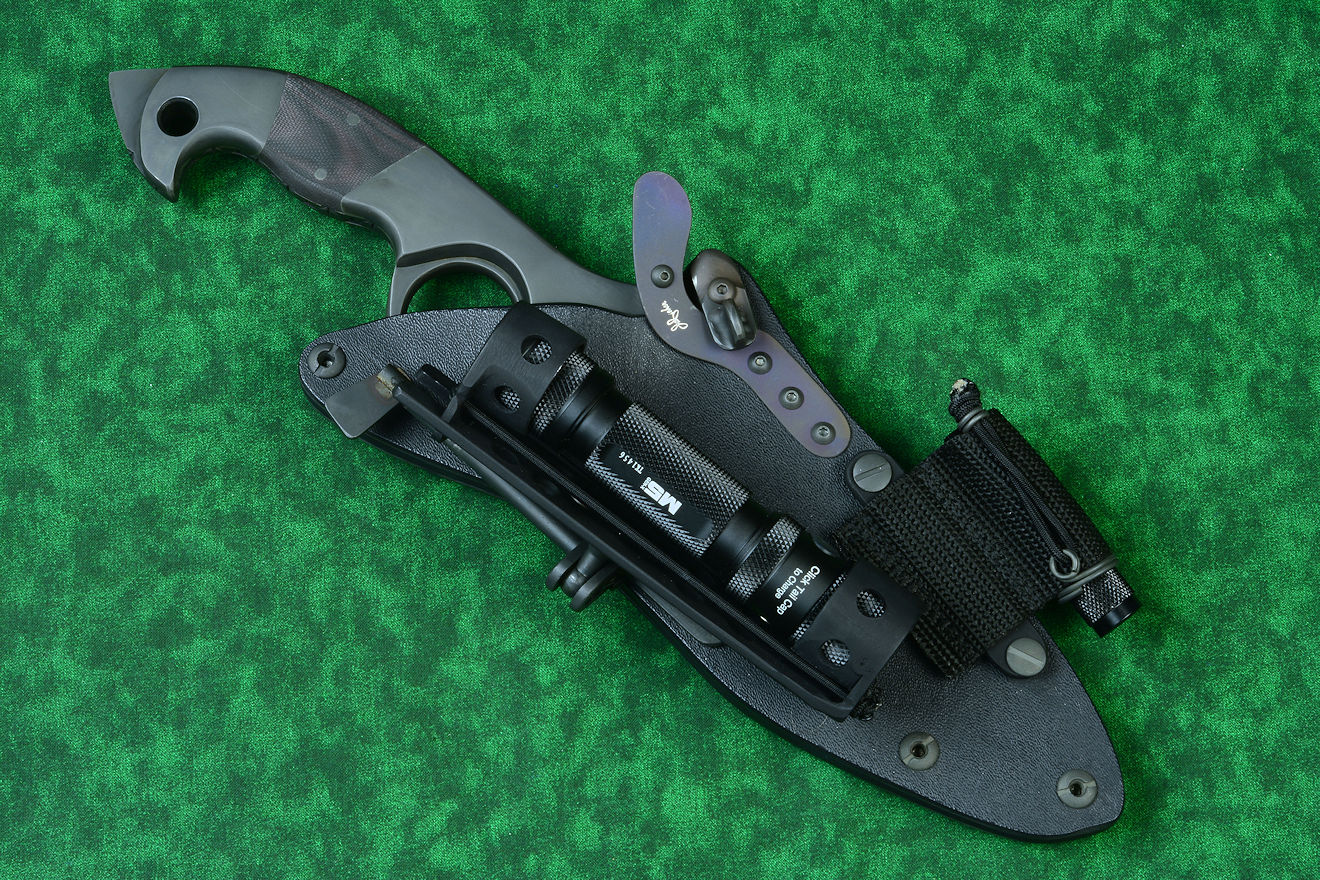Jay Fisher - Fine Custom Knives
New to the website? Start Here

"Raptor"
“Better to have, and not need, than to need, and not have.”
--Franz Kafka
Writer, 1883-1924
Many years ago, I was approached by a tactical officer that had an unusual and difficult job. He was charged with keeping watch over and confronting and eliminating the threat of grave robbers and pot hunters, thieves that were robbing ancient Central American sites of their treasure. The crimes against archaeology, against the history and anthropological wealth of a nation's ancestors, is an extremely dangerous and severe crime. His company, in an official capacity, watched over these ancient ruins to protect them from thieves and vandals. It's important to understand that the value of these treasures can be astronomical, and his was a tremendously hazardous and necessary occupation.
Since he did a lot of his surveillance at night, good flashlights were important, and he had the best he could carry for the situation and location. But, on more than one occasion, his main or "key" lamp had been damaged, had drained its battery, or had been made non-functional.
He asked if I could include an additional, smaller "emergency" lamp on his knife kit, one that wouldn't be too much effort to carry around, one that would at the very least, allow him to make it safely back to base and camp. This was the birth of the LIMA.
The acronym LIMA stands for "Lamp Independent Mount Assembly," and, like all of my tactical sheath components, it's my own invention. It's an extremely lightweight adjunct that can be used when your key light fails, or in the daytime when you aren't carrying your main flashlight, and need to look into a dark hole or enter an unlighted place. It is so innocuous that it's often forgotten on the sheath, but in critical times is immediately available. It is so tremendously popular that it's been demanded on all of my counterterrorism knife kits, because of the saying, "two flashlights are one flashlight, and one flashlight is no flashlights." If you are an active, outdoor person, you know exactly what I'm writing about, since being a mechanical and electrical device, failure will, sooner or later, visit you in the wilderness, and at the very worst time.
For the reader, the reasons for a small lamp on the tactical sheath are numerous, but experience is the best reference. When have you been out in the middle of the day, and needed to peek into a downed log, a small cave, a ruin, well, or dark hole? Have you been caught far away from camp without a lamp and the daylight is fading fast? Have you needed just enough light to see your way over rocks and rough terrain, but not a blinding flood lamp that can alert others and mark you as a target? Maybe you just needed to see your way around an obstacle, through some brush, or needed to read a map or compass. Maybe you needed to catch someone's attention, see your way to reload or re-chamber a misfire, or clean and service your critical outdoor equipment in the middle of an excursion. Maybe you have a small injury and want to see just what's going on. Or maybe you want a small spotlight that can illuminate nearby eyes that may be looking back at you. This is the philosophy of this small light. It's not your main camp beacon, it's simply a lightweight, useful adjunct that can get you through difficulties. It can also act as a backup when your main light fails.
The LIMA is always there, on your sheath or on certain accessories (UBLX), ready, quietly waiting and hardly noticeable. I wouldn't consider a tactical knife sheath complete without one.

At the time I made the first LIMA, the best flashlight (or torch for my friends across the pond) was the Maglite Solitaire®. The Solitaire was (and still is in some cases) a single AAA-battery powered xenon-lamp bulb anodized aluminum flashlight that was called a "keychain" light, and at the time was the best for the application. I came up with a mounting system that frankly, has not changed much in many, many years.
The Maglite Solitaire is called a Keychain/Backpack light, but it was tough and up to the job. I didn't want to add a heavy or bulky main beacon to the package, but an accessory that was light and small, yet durably built. Including the special fittings, this light accessory weighs about one ounce. It is about 3.25" long, and less than one half of an inch in diameter. On a knife sheath rig that may weigh several pounds (for a large tactical knife size), this is hardly noticeable.
I wanted a light that was tough, made of durable materials, and one that has a proven reputation of reliability. Maglite® makes their flashlights from machined aluminum, with O-ring seals and nickel plated conductors. There are no miniature switches in the Solitaire, and simply twisting the lens cap focuses the beam from spot to flood, just like the big Maglites. They included a spare bulb in the base of the xenon models, and the simple fluted knurling on the anodized black surface was fairly easy to grip when the lamp is wet or muddy. At that time, this was the best light for the application. But then, things improved.
Along came LED (Light Emitting Diode) technology. LEDs are far and away better than all filament bulbs. They don't wear out, they are mechanically stronger, they are extremely efficient, and they are getting better all the time. In the early days of LEDs, I even upgraded individual Maglite Solitaires to LED bulbs, since Maglite didn't make them. Then, Maglite caught on and started making LED Solitaires. Most of my pre-2018 LIMAs have LED bulbs.
The Solitaire is a pretty good light. But all good things must come to an end, and be upgraded. This is why I've moved on to the next level, and the reasons are pretty surprising.
Flashlight technology is drastically improving. LEDs are intensifying, drawing less current, and readily accept programming and variable intensity and other options. This is why my newer LIMAs (starting in 2018) are sported ThruNIte Ti3 models.
Then, they quit making the ThruNite Ti3. You can still see some of the older customers begging ThruNite to bring them back, but alas, we have to work with what we can get. So, an improvement was necessary, and that brings me to the Olite I1R 2 Pro. The nicest thing about this Olite is that it's almost half the size of the ThruNite, and is rechargeable. In the early days, rechargeable meant that a light was unusable, but since everything is going to USB-C, power options are much more available.
The comparison chart below will give you a clear idea of reason for the upgrade to the ThruNIte Ti3:
| Feature, ANSI, NEMA FL-1 Standard | Maglite LED Solitaire® | ThruNite Ti3® | Olite I1R 2 Pro |
| Battery | 1-AAA | 1-AAA | Rechargeable |
| To Operate/Lumens | Twist head to on/37 Lumens, non-adjustable | Twist head once to Firefly Mode/0.04 Lumens Twist head twice to Low Mode/ 12 Lumens Twist head three times to High Mode/120 Lumens Twist head through two cycles to Strobe Mode/120 Lumens |
5 Lumens Twist On 180 Lumens Twist More |
| Run Time | 1 hour, 45 minutes, non-adjustable | Firefly Mode: 115 hours Low Mode: 6.3 hours High Mode: 0.5 hours Strobe Mode (High): 1 hour |
Low: 12 hours High: 23 minutes |
| Peak Beam Intensity | 748 Candelas | 625 Candelas | N/A |
| Beam Distance | 55 Meters (180 feet) | 50 Meters (164 feet) | 48 Meters (157 feet) |
| Impact Resistance | 1 meter | 1.2 Meters | 1.5 Meters |
| Water Resistance | Water resistant to 1 meter for 30 minutes, IPX-7 | Water resistant to full and continual immersion, IPX-8 | Water resistant to full and continual immersion, IPX-8 |
| Aluminum Coating | Anodized | Type III, Hard-anodized | Type III, Hard-anodized |
| Lens material | Polycarbonate | Glass | TIR Optic |
The Maglite was and is a decent flashlight, but the ThruNite Ti3 is much, much better. It has more variability to set the custom light output, it is incredibly intense when needed, it's more waterproof, it has a glass lens that's less likely to scratch and fog than plastic, and it's just a tougher, better lamp. The only thing it lacks is a focusable lens which is not necessary on all but the larger lamps. A surprising feature is the strobe; in an emergency, at 120 lumens flashing, this little light my very well save your life!
But since they don't make the Ti3 anymore, the Olite is the new player. First, no more buying or carrying extra batteries; it's rechargeable. The light from this little thing is intense, and the low level light is reasonable. Yes, it's a more expensive light, but worthy.
Oh, and if I forgot to mention, the ThruNite Ti3 is physically smaller and about half the weight!
And on top of that, the Olite is half the size and much lower weight than the ThruNite!
So this lets me make even a smaller, lighter LIMA holder accessory, and lightens the load on my clients wearing the sheath.
It's too bad that Maglite hasn't kept up with the market and features on these smaller, critical lamps. It would be nice if American companies could keep up; I certainly make it my goal to offer the most advanced knives money can buy. But when it comes to the accessories, I'm dedicated to offering adjuncts that work with the best option for my clients. It's about solving my client's problems, and offering the very best I can find for the individual application, since in combat, rescue, and survival, the flashlight could literally mean life or death.
One thing I will guarantee, and that is when you see the output of this tiny Olite, you will be very impressed!

I wanted a minimum of pieces to mount the LIMA, but I wanted it strong. I also wanted it to yield a bit when brushing against objects, and I wanted it to be able to be mounted just about anywhere on the tactical knife sheath.

The LIMA can be mounted anywhere on the sheath that has the 2.5" bolt spacing pattern. It can be mounted in front of the sheath, or in the back of the sheath. It can be mounted with the web inward, (inboard) and the flashlight over the sheath (for a reduced footprint) or it can be mounted with the lamp protruding outward (outboard), away from the welts, in the front or back. Some clients find it easier to access the LIMA when it is outwardly (outboard) mounted, some like the more compact arrangement of the LIMA atop the sheath face or front (inboard). Some like it in back, out of sight, away from anything they might bump into with their sheath.
With the assortment of machine screws and fasteners I include with the kits, the client is assured of a large number of mounting options. The lamp can even be mounted with lens-up or lens-down. Some clients like the lens up because they can see if they have mistakenly left the flashlight turned on, and others like it lens-down so that debris will be less likely to cloud the lens. It's up to the user.
The LIMA can even be mounted on the back side, over the top of the belt loops, if the wearing allows it in the client's arrangement. This can allow wearing of web that traps the knife sheath (over the top of the sheath instead of the sheath on top of the web). If there is enough room, the LIMA can even be worn completely hidden in the back of the sheath. If mounted over the belt loops, the web presses down on the aluminum belt loop, holding it in place, and the included button head cap screws hold the entire assembly together. There is also the option of an offset mounting, where one end of the LIMA mount frame is on top of the belt loop and the other end is screwed through an open sheath hole.
The only thing to remember is that there must be a 2.5" spacing between the sheath holes. If the spacing is not there, or is not 2.5", the screws can't be forced; they will cross-thread and be ruined! Every sheath is different, since every knife is a different size, but this photo set below should give you a good idea of the mounting potential of the LIMA.
The only place that the LIMA absolutely can't be mounted, even if there is the 2.5" spacing, is over the dogleg spring of my hybrid tension-lock sheath, since it would interfere with the spring movement. On the positively locking sheath, there is no such limitation.
Like all of the accessories, don't use the force of Thor's Hammer to tighten the machine screws when mounting the LIMA. A snug fit will be enough, the screws won't fall or vibrate out easily. Over-tightening will just deform an aluminum strap. If you over-tighten one of the stainless steel LIMA straps, you may snap off a machine screw! Not necessary; snug is good.

The flashlight is removed from the web frame by simply pulling off the ring that is retained by the shock cord (bungee). Each lamp type operates differently, but generally, they work by twisting the head of the lamp, or twisting it multiple times.
The neat thing is the lamp can be turned on while in the web frame and still mounted on the knife sheath, so on hikes or working around camp, the lowest setting can give a little illumination while still on the sheath and body. Some clients also like this for night hikes and location identification.
Off the body, the LIMA—on low—can help to locate the knife and sheath if it's laying around camp. Since on the lowest setting the battery will last many hours, leaving the lamp on for an hour or two on the Firefly setting won't cost too much juice.
Out of the web frame, the elastic bungee and ring retainer also has some use. Since the flashlight is so small, the bungee can be looped around the finger like a ring, and the lamp can illuminate tasks while mounted to the finger, in a "hand's-free" type of arrangement. The bungee can also be used to mount the small light to any small rod or tube shape, like a branch, a tent pole, or tactical gear.
Like most of my accessories, there is very little care whatever for this device. The metal parts are care-free, and the webbing and stitching is waterproof and almost indestructible. If the web gets muddy, hose it off.
The only part that will eventually wear is the shock cord, which is easily replaced. With this type of cord, you'll see the white interior strands when it's time to replace it. It's common 1/8" diameter elastic cord, found in every hardware store and plentifully online. It's good to always have some of it around anyway, since it's very handy for loads, packs, and gear. Just to keep you going, I've included an extra length for replacement when needed.
The flashlight has its own life, operation, and sequence. Included is the paperwork for the lights; they are well made and durable. Once you have it on your gear, you'll wonder why you never had it before!
| Main | Purchase | Tactical | Specific Types | Technical | More |
| Home Page | Where's My Knife, Jay? | Current Tactical Knives for Sale | The Awe of the Blade | Knife Patterns | My Photography |
| Website Overview | Current Knives for Sale | Tactical, Combat Knife Portal | Museum Pieces | Knife Pattern Alphabetic List | Photographic Services |
| My Mission | Current Tactical Knives for Sale | All Tactical, Combat Knives | Investment, Collector's Knives | Copyright and Knives | Photographic Images |
| The Finest Knives and You | Current Chef's Knives for Sale | Counterterrorism Knives | Daggers | Knife Anatomy | |
| Featured Knives: Page One | Pre-Order Knives in Progress | Professional, Military Commemoratives | Swords | Custom Knives | |
| Featured Knives: Page Two | USAF Pararescue Knives | Folding Knives | Modern Knifemaking Technology | My Writing | |
| Featured Knives: Page Three | My Knife Prices | USAF Pararescue "PJ- Light" | Chef's Knives | Factory vs. Handmade Knives | First Novel |
| Featured Knives: Older/Early | How To Order | 27th Air Force Special Operations | Food Safety, Kitchen, Chef's Knives | Six Distinctions of Fine Knives | Second Novel |
| Email Jay Fisher | Purchase Finished Knives | Khukris: Combat, Survival, Art | Hunting Knives | Knife Styles | Knife Book |
| Contact, Locate Jay Fisher | Order Custom Knives | Serrations | Working Knives | Jay's Internet Stats | |
| FAQs | Knife Sales Policy | Grip Styles, Hand Sizing | Khukris | The 3000th Term | Videos |
| Current, Recent Works, Events | Bank Transfers | Concealed Carry and Knives | Skeletonized Knives | Best Knife Information and Learning About Knives | |
| Client's News and Info | Custom Knife Design Fee | Military Knife Care | Serrations | Cities of the Knife | Links |
| Who Is Jay Fisher? | Delivery Times | The Best Combat Locking Sheath | Knife Sheaths | Knife Maker's Marks | |
| Testimonials, Letters and Emails | My Shipping Method | Knife Stands and Cases | How to Care for Custom Knives | Site Table of Contents | |
| Top 22 Reasons to Buy | Business of Knifemaking | Tactical Knife Sheath Accessories | Handles, Bolsters, Guards | Knife Making Instruction | |
| My Knifemaking History | Professional Knife Consultant | Loops, Plates, Straps | Knife Handles: Gemstone | Larger Monitors and Knife Photos | |
| What I Do And Don't Do | Belt Loop Extenders-UBLX, EXBLX | Gemstone Alphabetic List | New Materials | ||
| CD ROM Archive | Independent Lamp Accessory-LIMA | Knife Handles: Woods | Knife Shop/Studio, Page 1 | ||
| Publications, Publicity | Universal Main Lamp Holder-HULA | Knife Handles: Horn, Bone, Ivory | Knife Shop/Studio, Page 2 | ||
| My Curriculum Vitae | Sternum Harness | Knife Handles: Manmade Materials | |||
| Funny Letters and Emails, Pg. 1 | Blades and Steels | Sharpeners, Lanyards | Knife Embellishment | ||
| Funny Letters and Emails, Pg. 2 | Blades | Bags, Cases, Duffles, Gear | |||
| Funny Letters and Emails, Pg. 3 | Knife Blade Testing | Modular Sheath Systems | |||
| Funny Letters and Emails, Pg. 4 | 440C: A Love/Hate Affair | PSD Principle Security Detail Sheaths | |||
| Funny Letters and Emails, Pg. 5 | ATS-34: Chrome/Moly Tough | ||||
| Funny Letters and Emails, Pg. 6 | D2: Wear Resistance King | ||||
| Funny Letters and Emails, Pg. 7 | O1: Oil Hardened Blued Beauty | ||||
| The Curious Case of the "Sandia" |
Elasticity, Stiffness, Stress, and Strain in Knife Blades |
||||
| The Sword, the Veil, the Legend |
Heat Treating and Cryogenic Processing of Knife Blade Steels |